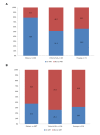Engagement with HIV prevention treatment and care among female sex workers in Zimbabwe: a respondent driven sampling survey
- PMID: 24143203
- PMCID: PMC3797143
- DOI: 10.1371/journal.pone.0077080
Engagement with HIV prevention treatment and care among female sex workers in Zimbabwe: a respondent driven sampling survey
Abstract
Objectives: To determine the HIV prevalence and extent of engagement with HIV prevention and care among a representative sample of Zimbabwean sex workers working in Victoria Falls, Hwange and Mutare.
Design: Respondent driven sampling (RDS) surveys conducted at each site.
Methods: Sex workers were recruited using respondent driven sampling with each respondent limited to recruiting 2 peers. Participants completed an interviewer-administered questionnaire and provided a finger prick blood sample for HIV antibody testing. Statistical analysis took account of sampling method.
Results: 870 women were recruited from the three sites. HIV prevalence was between 50 and 70%. Around half of those confirmed HIV positive were aware of their HIV status and of those 50-70% reported being enrolled in HIV care programmes. Overall only 25-35% of those with laboratory-confirmed HIV were accessing antiretroviral therapy. Among those reporting they were HIV negative, 21-28% reported having an HIV test in the last 6 months. Of those tested HIV negative, most (65-82%) were unaware of their status. Around two-thirds of sex workers reported consistent condom use with their clients. As in other settings, sex workers reported high rates of gender based violence and police harassment.
Conclusions: This survey suggests that prevalence of HIV is high among sex workers in Zimbabwe and that their engagement with prevention, treatment and care is sub-optimal. Intensifying prevention and care interventions for sex workers has the potential to markedly reduce HIV and social risks for sex workers, their clients and the general population in Zimbabwe and elsewhere in the region.
Conflict of interest statement
Figures




References
-
- WHO (2011) Preventing HIV in Sex Work Settings in sub Saharan Africa. Geneva: World Health Organization.
-
- Pauw I, Brener L (2003) 'You are just whores - you can't be raped': barriers to safer sex practices among women street sex workers in Cape Town. Cult Health Sex 5: 465-481. doi:10.1080/136910501185198. - DOI
-
- Scorgie F, Nakato D, Akoth DO, Netshivhambe M, Chakuvinga P et al. (2011) I Expect to be Abused and I Have Fear: Sex workers' Experiences of Human rights Violations and Barrers to Accessing Healthcare in Four African Countries. Cape Town: African Sex Worker Alliance.
-
- Arnott J, Crago A-L (2009) Rights Not Rescue: A Report on Female, Male, Trans Sex Workers' Human RIghts in Botswana, Namibia, and South Africa. New York City: Open Society Institute.
Publication types
MeSH terms
LinkOut - more resources
Full Text Sources
Other Literature Sources
Medical
Research Materials

